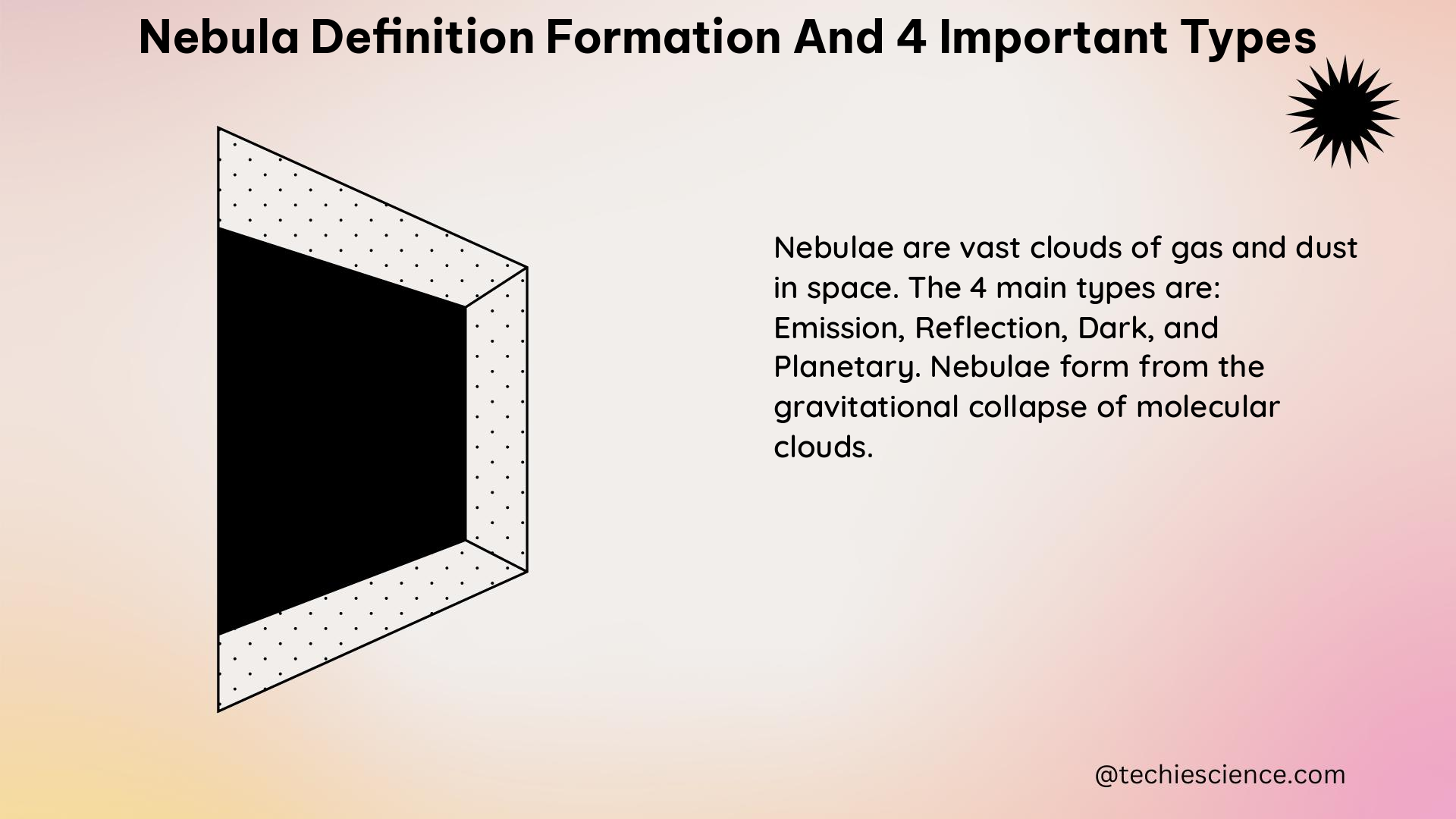Nebulae are vast, enigmatic clouds of gas and dust that dot the cosmic landscape, playing a crucial role in the birth and evolution of stars. From the vibrant Orion Nebula to the eerie Horsehead Nebula, these celestial phenomena captivate astronomers and stargazers alike. In this comprehensive guide, we’ll delve into the definition, formation, and four important types of nebulae, providing a wealth of technical details and quantifiable data to help you understand these remarkable structures.
Nebula Definition: Unveiling the Cosmic Clouds
A nebula is a giant interstellar cloud of dust, hydrogen, helium, and other ionized gases. These clouds can range in size from a few light-years to hundreds of light-years in diameter, with a density that is generally greater than the surrounding space, but still far less dense than any vacuum we can create on Earth. Nebulae are primarily composed of the two most abundant elements in the universe: hydrogen and helium.
The term “nebula” is derived from the Latin word for “cloud,” and these celestial structures have been observed and studied for centuries, with their true nature only recently being understood. Nebulae are not just passive clouds of gas and dust; they are dynamic, ever-changing environments that play a crucial role in the formation and evolution of stars.
Nebula Formation: The Gravitational Collapse

Nebulae are formed when portions of the interstellar medium, the diffuse gas and dust that fills the space between stars, experience a gravitational collapse. This collapse can be triggered by a variety of events, including:
- Supernova Explosions: The shockwaves from a supernova can compress nearby interstellar material, leading to the formation of a new nebula.
- Shock Waves from Nearby Stars: Powerful stellar winds and jets from young, massive stars can also compress and shape the surrounding interstellar material, creating new nebulae.
- Collisions of Molecular Clouds: When two or more molecular clouds collide, the resulting compression can trigger the formation of a new nebula.
The gravitational collapse of the interstellar material leads to the formation of a dense core, which can eventually become the birthplace of a new star or a cluster of stars. This process is known as star formation, and nebulae are often associated with active star-forming regions.
The Four Important Types of Nebulae
Nebulae can be classified into four main types, each with its own unique characteristics and formation processes:
1. Emission Nebulae
Emission nebulae are characterized by the emission of their own light, which is produced by the ionization of the gas within the nebula. This ionization is typically caused by the intense ultraviolet radiation from nearby hot, young stars. The most famous example of an emission nebula is the Orion Nebula, located approximately 1,300 light-years from Earth and spanning a diameter of around 24 light-years.
The process of emission nebula formation can be described by the following steps:
1. Nearby hot, young stars emit intense ultraviolet radiation.
2. This radiation ionizes the hydrogen and other elements within the nebula, causing them to emit their own characteristic light.
3. The emitted light from the ionized gas creates the distinctive glow of an emission nebula.
Mathematically, the intensity of the emitted light from an emission nebula can be described by the following equation:
$I = n_e n_i q_i \alpha_i$
Where:
– $I$ is the intensity of the emitted light
– $n_e$ is the electron density
– $n_i$ is the density of the ionized species
– $q_i$ is the rate coefficient for the transition
– $\alpha_i$ is the recombination coefficient for the ionized species
By measuring the intensity of the emitted light and the various parameters in this equation, astronomers can gain valuable insights into the physical properties and composition of emission nebulae.
2. Reflection Nebulae
Reflection nebulae are characterized by the reflection of light from nearby stars. Unlike emission nebulae, reflection nebulae do not emit their own light; instead, they scatter the light from nearby stars, causing the nebula to appear bright. Reflection nebulae are often associated with young, hot stars that have not yet begun to ionize the surrounding gas.
The formation of a reflection nebula can be described as follows:
1. A young, hot star emits light in all directions.
2. The gas and dust in the surrounding nebula scatter this light, causing the nebula to appear bright.
3. The scattered light creates the distinctive appearance of a reflection nebula.
The brightness of a reflection nebula can be described by the following equation:
$B = \frac{L_\star}{4\pi r^2} \times \sigma$
Where:
– $B$ is the brightness of the reflection nebula
– $L_\star$ is the luminosity of the nearby star
– $r$ is the distance between the star and the nebula
– $\sigma$ is the scattering coefficient of the gas and dust in the nebula
By measuring the brightness of a reflection nebula and the various parameters in this equation, astronomers can determine the properties of the nearby star and the composition of the nebula.
3. Planetary Nebulae
Planetary nebulae are a unique type of nebula that are formed when a low-mass star, similar to our Sun, reaches the end of its life cycle. As the star’s core runs out of fuel, it begins to shed its outer layers, ejecting a shell of gas and dust into the surrounding space. This ejected material forms the distinctive shape of a planetary nebula, which can resemble a planet when viewed through a telescope.
The formation of a planetary nebula can be described by the following steps:
1. A low-mass star, such as our Sun, reaches the end of its main sequence life cycle.
2. The star’s core begins to contract, causing the outer layers to expand and cool.
3. Helium flashes in the star’s interior cause the outer layers to be ejected, forming a shell of gas and dust around the star.
4. The ejected material forms the distinctive shape of a planetary nebula.
The physical properties of a planetary nebula can be described by the following equations:
$T_\text{eff} = \left(\frac{L_\star}{4\pi R_\star^2 \sigma}\right)^{1/4}$
$L_\star = 4\pi R_\star^2 \sigma T_\text{eff}^4$
Where:
– $T_\text{eff}$ is the effective temperature of the central star
– $L_\star$ is the luminosity of the central star
– $R_\star$ is the radius of the central star
– $\sigma$ is the Stefan-Boltzmann constant
By measuring the physical properties of a planetary nebula and applying these equations, astronomers can determine the characteristics of the central star and the ejection process that formed the nebula.
4. Dark Nebulae
Dark nebulae are a unique type of nebula that appear as dark, opaque regions in the sky. These nebulae are composed of dense, cold molecular clouds that block the light from background stars, creating a silhouette-like effect. Dark nebulae are often associated with star-forming regions, as the dense, cold material can collapse to form new stars.
The formation of a dark nebula can be described as follows:
1. Portions of the interstellar medium become dense and cold, forming molecular clouds.
2. The high density and low temperature of the molecular clouds cause them to appear as dark, opaque regions in the sky.
3. The dense material in the dark nebula can collapse under its own gravity, leading to the formation of new stars.
The physical properties of a dark nebula can be described by the following equations:
$n_\text{H_2} = \frac{A_V}{5.8 \times 10^{-22} \, \text{cm}^2}$
$M_\text{cloud} = \frac{4}{3} \pi R^3 \rho$
Where:
– $n_\text{H_2}$ is the number density of molecular hydrogen
– $A_V$ is the visual extinction, a measure of the amount of light absorbed by the nebula
– $M_\text{cloud}$ is the mass of the molecular cloud
– $R$ is the radius of the molecular cloud
– $\rho$ is the density of the molecular cloud
By measuring the physical properties of a dark nebula and applying these equations, astronomers can gain insights into the structure and composition of these enigmatic cosmic structures.
Conclusion
Nebulae are fascinating and complex structures that play a crucial role in the birth and evolution of stars. From the vibrant emission nebulae to the eerie dark nebulae, each type of nebula has its own unique characteristics and formation processes. By understanding the technical details and quantifiable data associated with these celestial phenomena, we can gain a deeper appreciation for the dynamic and ever-changing nature of the universe.
References
- Osterbrock, D. E. (1989). Astrophysics of Gaseous Nebulae and Active Galactic Nuclei. University Science Books.
- Draine, B. T. (2011). Physics of the Interstellar and Intergalactic Medium. Princeton University Press.
- Tielens, A. G. G. M. (2005). The Physics and Chemistry of the Interstellar Medium. Cambridge University Press.
- Spitzer, L. (1978). Physical Processes in the Interstellar Medium. Wiley-Interscience.
- Dyson, J. E., & Williams, D. A. (1997). The Physics of the Interstellar Medium. Institute of Physics Publishing.

Hi, I am Sanchari Chakraborty. I have done Master’s in Electronics.
I always like to explore new inventions in the field of Electronics.
I am an eager learner, currently invested in the field of Applied Optics and Photonics. I am also an active member of SPIE (International society for optics and photonics) and OSI(Optical Society of India). My articles are aimed at bringing quality science research topics to light in a simple yet informative way. Science has been evolving since time immemorial. So, I try my bit to tap into the evolution and present it to the readers.
Let’s connect through